Americans, once devoted to large, V8-powered sedans, have been figuring out what they really want and need in a car. Increasingly the answer is a compact crossover. Sure, crossovers don't handle as well as cars. But most Americans drive on roads that require little in the way of handling. Fuel economy can be more of a concern. Taller and heavier, crossovers can't approach cars in mpg. Compared to the 2010-2012, the 2013 GLK 350 (reviewed earlier this year)is much more efficient, but its EPA ratings of 19/24 mpg remain well below those for a comparably-performing car, especially on the highway.
A solution is at hand. In European countries, the great majority of crossovers are bought with diesel engines. Late in the 2013 model year a diesel engine became available on this side of the Atlantic in the GLK. But, unlike in the Audi Q5 TDI (recently added as a 2014), the diesel engine in the GLK is a 2.1-liter four-cylinder, not a 3.0-liter V6. Can such a small engine tasked with motivating 4,248 lbs. deliver performance befitting a $50,000 Mercedes?
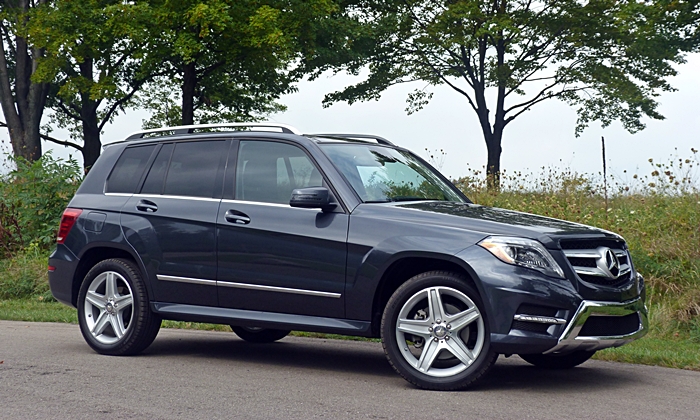
Overly rectilinear, or a welcome departure from the aero norm? more GLK-Class photos
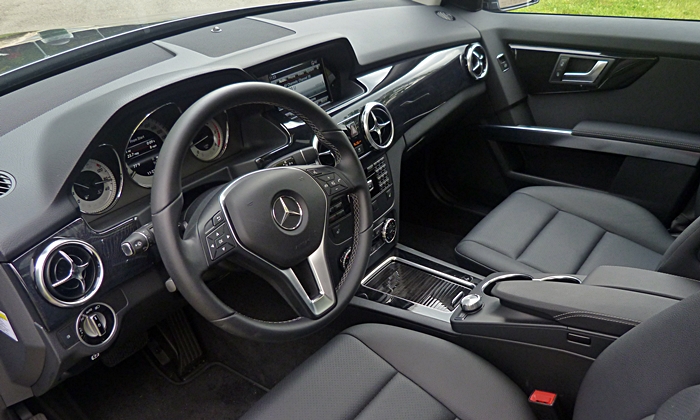
Compared to the 2010-2012 GLK, more wood, more chrome, more curves, better materials.
| |
Compared to the Q5 |
| Brand reputation & image |
 Better
Worse
Better
Worse
|
The smaller the Mercedes, the more heavily it tends to trade on the three-pointed star. So the #1 reason to consider a GLK250 carries over from the GLK350 review (text from the previous review in italics):
I don't personally put much stock in brands, with cars or anything else. But each time I have a Mercedes-Benz for a week the continuing power of the marque has been unavoidable.
Audi and BMW now command similar prices, but haven't yet acquired the same mystique. They probably never will for people born before 1980. Until the final years of the twentieth century, Audis were largely ignored as troublesome, modestly upgraded VWs and BMW was mostly known for the compact, still semi-affordable 3-Series. Neither could hold a candle to the company that invented the mass-produced automobile and that has been strongly associated with large, top-shelf automobiles ever since.
Gayla (the site's programmer, my wife) is not a car person. Her take on the GLK: "Of course it's a good car, it's a Mercedes." Some of my friends who are more into cars--and who own competing makes--similarly employ a different tone when asking about "the Mercedes." They could afford one, so why don't they own one? Partly because the brand's mystique cuts both ways. They're not interested in making such a strong status statement.
Can even a compact crossover make a strong status statement? Mercedes-Benz has done its best to make this so--check out the size of the three-pointed star on the GLK's grille.
| Fuel economy |
 Better
Worse
Better
Worse
|
Fuel economy was a "why not to buy" with the GLK350, as the gas-powered Mercedes-Benz crossover trails the competing Audi and BMW in this area. With the diesel, though, the tables turn. BMW doesn't offer a diesel X3 in North America, at least not yet. For 2014, Audi does offer a Q5 TDI.When I heard that Audi was going to offer a diesel compact crossover, I assumed that the engine in question would be a four-cylinder unit. Nope, it's a 240-horsepower 3.0-liter V6. The official line: a four-cylinder wouldn't suit Audi's performance-oriented brand image in the U.S.
With a much smaller engine and (partly as a result) a couple hundred pounds less curb weight, the GLK250 BlueTEC tops the Q5 in fuel economy. But, according to the EPA, only on the highway, with a rating of 33 mpg vs. 31.Both crossovers achieve an EPA city rating of 24 mpg.
In the real world, the GLK250 impresses in suburuban driving, with the trip computer usually reporting averages from 31 to 35, and on one run to my son's school nearly 40. This is about 50 percent better than in the GLK350.
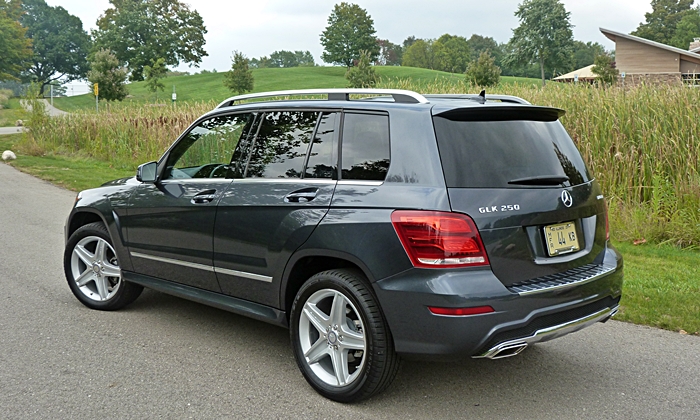
New LED tail light assemblies.
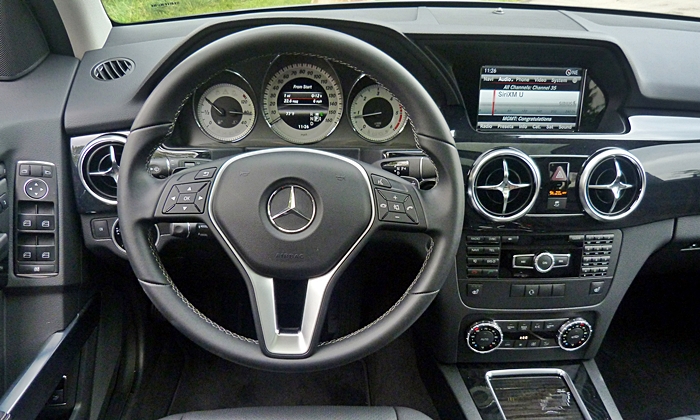
Instruments illegible at dusk. HVAC controls hard to adjust at a glance due to location.
| Interior styling |
 Better
Worse
Better
Worse
|
Returning to the GLK350 review:
Looking beyond the grille, the GLK's exterior has always appeared not quite premium to me. The truncated, very square rear end looks more Subaru than Mercedes. Yet I must grant that the GLK's exterior makes a stronger design statement than those of the Audi Q5 and BMW X3. For 2013 both ends of the GLK have gained fancier, LED-filled lamp assemblies.
But the most notable upgrades happened inside the GLK. The original interior was overly plain and chock full of flat, hard black plastic. Even more than the exterior it didn't suit the brand. Back in 1970s and 1980s Mercedes had plain interiors compared to Cadillacs and Lincolns, but since at least 1990 premium car buyers have expected a premium interior. These buyers should find the 2013 GLK's interior, with more curves, more wood, more chrome trim, and upgraded materials, much more suitable. Now it's Audi's and BMW's turn for upgrades.
| Ride smoothness |
 Better
Worse
Better
Worse
|
Back when Mercedes lacked glitz, how did they gain and maintain a premium image? Partly by oozing solidity. The GLK350 carries on this part of the marque's tradition. The average car has gotten much more solid over the last two decades, with even Chevrolets and Fords now challenging upscale brands on this basis. But when pulling a door closed or driving down the road the GLK350 still feels at least a little more solid than the others.
Last time around, I compared the GLK to the firmly suspended BMW X3, so the Mercedes easily won the ride quality contest. Compared to the Audi, the Mercedes also rides more smoothly and steadily, if still not plushly, but the difference isn't as large. Noise levels are premium car low in all three crossovers.
| Driving position & visibility |
 Better
Worse
Better
Worse
|
Sitting high within a tidy package is what the compact crossover category is all about, and the GLK has this base covered. The windshield is more upright and more distant than most. This will count as a positive for some people, a negative for others. The quasi-Hummer view forward does contribute to a feeling of unstoppable solidity. The side and rear windows are tall by current standards, for good visibility in those directions as well.
| |
Compared to the Q5 |
| Handling |
 Better
Worse
Better
Worse
|
The GLK250 handles just like the GLK350, so, with some minor changes...
Mercedes-Benz proclaims the GLK as the "SUV embodiment of a sport sedan's soul." The right boxes have been checked: nearly balanced weight distribution, 19-inch wheels, and (for 2013) paddle shifters for the transmission, all as standard equipment. The retuned suspension does manage body motions and lean better. The new, electric-assist steering provides no more feedback than the numb old hydraulic unit, but contains less slop. Drive the GLK casually, and it behaves well.
But push the baby Benz ute and the veneer of sportiness falls away. Instead, in hard turns you'll discover limited grip from the Michelin Latitude Tour HP tires as the nose plows towards the curb and a non-defeatable, far-from-transparent stability control system jerks your chain.
Premium compact crossover buyers looking for fun are much more likely to find it in the competing Audi, BMW, Infiniti, or Volvo.
Compared to the BMW and especially the Mercedes, the Audi drives more like a car. Then again, maybe you don't want a crossover that handles like a car.
| Rear seat room & comfort |
 Better
Worse
Better
Worse
|
Expect the GLK to grow when it is next fully redesigned. A smaller MLK is on the way to battle the upcoming Audi Q3 and just-arrived BMW X1. For 2013, the GLK's body structure remains essentially the same, so rear seat knee room remains just sufficient for a man of average height sitting behind another such man. (Headroom, on the other hand, is abundant.) Among competitors, only the Infiniti EX37 has a tighter rear seat. The Audi, BMW, and Volvo all offer knees another inch or three. Seat comfort is debatable. To my bottom, the GLK's seats feel overly firm.
Cargo space is similarly short of the segment average. The GLK's 54.7 cubic feet isn't far behind the Audi's 57.3 but well below the X3's 63.3. That truncated tail has a downside beyond aesthetics.
But do these shortcomings really matter? For most people nearly all of the time, there's enough space.
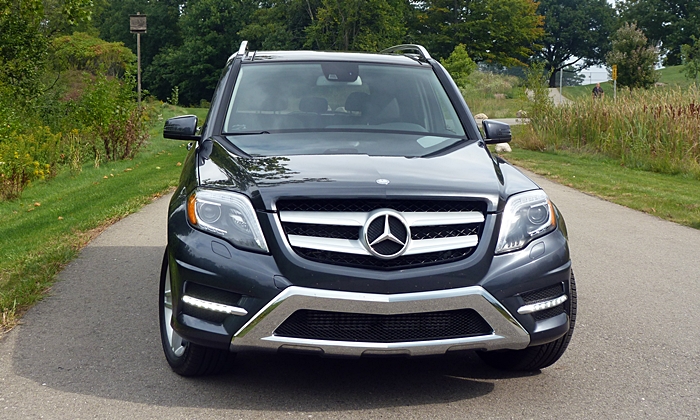
Especially with the AMG Styling Package, a much bolder face than the 2010-2012 GLK.
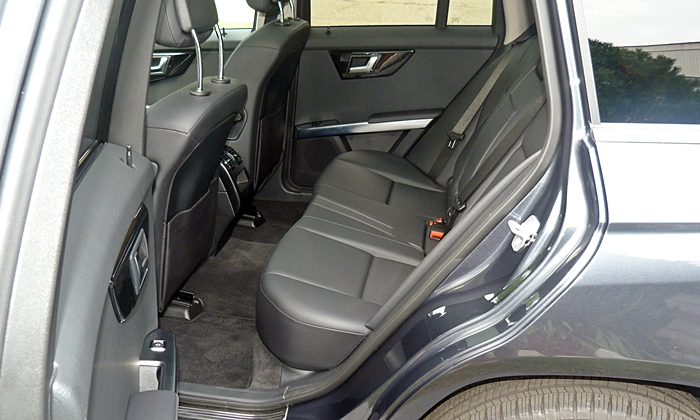
Adults can fit in the GLK's back seat, but with little knee room to spare.
| Controls and instruments |
 Better
Worse
Better
Worse
|
No big issues here, just a few minor niggles. At dusk, the main instruments are difficult to read. The HVAC controls at the base of the center stack would be easier to use if they were angled upwards towards the driver's eyes, were located higher up, or both. The knob-based COMAND system isn't too difficult to use once you figure out its basic structure (primary menu along the top edge, secondary menu along the bottom edge, content in the middle), but often requires a lot of toggling.
On the plus side, the GLK's infotainment system can now connect you to news, Google search, Yelp, Facebook, and (when parked) the entire Internet for $14 a month on top of the $280/year basic mbrace telematics fee. Also, Mercedes has finally located the turn signal stalk above the cruise control stalk. Those not thoroughly familiar with Mercedes are much less likely to set the cruise when attempting to signal a turn.
In base form, the Audi's infotainment interface is harder to use, as the control knob is located at the base of the center stack. Add nav, though, and the control knob moves to a much more ergonomic location on the center console.
| |
Compared to the Q5 |
| Powertrain performance |
 Better
Worse
Better
Worse
|
The Mercedes-Benz GLK250 BlueTEC cannot overcome the laws of physics, so it isn't as quick as the Q5 TDI. Down two cylinders, the GLK's engine also isn't as smooth or as quiet. Though the BlueTEC's sound isn't loud or objectionable, some diesel grumble waffles in. (People in search of a different driving experience might rate this a pro.) Unless you notice the low rpm shifts, it's difficult to even tell that the Audi's engine is a diesel.
But I'm not going to list powertrain performance as a reason not to buy the GLK250 because it's far quicker than I expected it to be, and easily as quick as the typical buyer will ever need it to be. Perhaps if I'd paid closer attention to the specs, I would not have been so surprised. Audi might have opted not to offer the Q5 here with a four-cylinder diesel, but the VW Group's 2.0-liter four-cylinder diesel currently maxes out at 177 horsepower (and only 140 horsepower in the version offered in compact Volkswagens here). The new Mercedes 2.1-liter kicks out a much more vigorous 200.
And peak horsepower isn't the real story with diesels, since they cannot rev as high as gas engines. Rather, diesels excel at low rpm power, as indicated by their peak torque (horsepower = torque x rpm). The Euro-market Audi 2.0-liter diesel can produce 280 lb-ft of twist at a low 1,750 rpm. Plenty for a compact sedan, less adequate for a heavier crossover. The Mercedes 2.1-liter diesel (also newly available in the E-Class midsize sedan) cranks out 369 lb-ft at 1,600 rpm. Though only 70 percent the size of the V6 in the Q5 TDI, it can generate 86 percent as much torque.
The GLK350's gasoline 3.5-liter V6 might have a stronger top end, with 302 horsepower, but it cannot come close to the GLK250's relatively small diesel at low rpm, with a much lower peak torque output of 273 lb-ft at a much higher 3,500 rpm. In typical suburban driving the diesel feels stronger.
| Price or payments |
 Better
Worse
Better
Worse
|
With the GLK250, pricing also shifts out of the "why nots." It's only $500 less than the GLK350, but diesels usually cost more than gas engines. Credit the reduced cylinder count.
The Q5 TDI lists for $5,300 more than a comparably-equipped four-cylinder 2.0T and $2,100 more than a V6 3.0T.
Compare the GLK250 to the Q5 TDI, and the Mercedes starts far lower, $39,905 (for 2014) vs. $47,395. But this is partly because the TDI cannot be bought without the mid-level "Premium Plus" package. Comparably equip the two, and the now $51,815 Mercedes remains $3,580 less before adjusting for feature differences, and about $3,100 less afterwards.
A decade ago, the thought of an Audi that cost even a dime more than a comparable Mercedes would have been laughable. Today the Audi can cost significantly more.
Of course, the $3,000 price difference can largely be chalked up to the difference in cylinder count. But would two more cylinders be worth $3,000 to the typical buyer? Mercedes has bet that they wouldn't , and they're likely right.
Note: the $50,485 tested car didn't include leather upholstery, a premium audio system, or some of the safety-related options that were a "why to buy" for the GLK350 reviewed earlier. But it did include a $1,990 AMG Styling Package. This package has no effect on how the car performs, so unless you really like the appearance of the AMG wheels and fascias it will seem like a lot of money for very little.
Diesels excel at low-end torque and fuel efficiency.Given their additional mass and the way they are typically driven (i.e. not like a sports car), crossovers need low-end torque and better fuel efficiency. This would seem a match made in heaven, but until recently you couldn't buy a diesel-powered compact crossover in North America. Now we have two.
Impressive as the GLK250's specs are for a diesel four-cylinder, they can't communicate how at home this engine feels in the GLK. It just feels right. The GLK350 and I never quite hit it off. Something always seemed lacking to me. Apparently that something was a diesel engine, as I enjoyed driving the GLK250 considerably more than its gas-powered counterpart. The trip computer reports of 30-40 mpg didn't hurt.
But what about the Audi? While the Q5 TDI feels more powerful and more car-like than the GLK250, it is also more expensive, doesn't ride quite as smoothly, and uses a little more fuel. Aside from these differences, many people will no doubt choose between the two based on their preference for the Audi's curves or the Mercedes-Benz's chiseled angles. In either case, the diesel strikes me as the way to go.
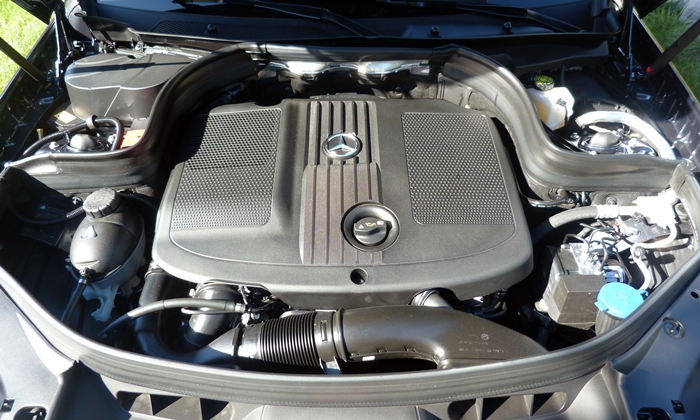
Though only a 2.1-liter four-cylinder, the GLK250's diesel engine can produce 369 lb-ft of torque.
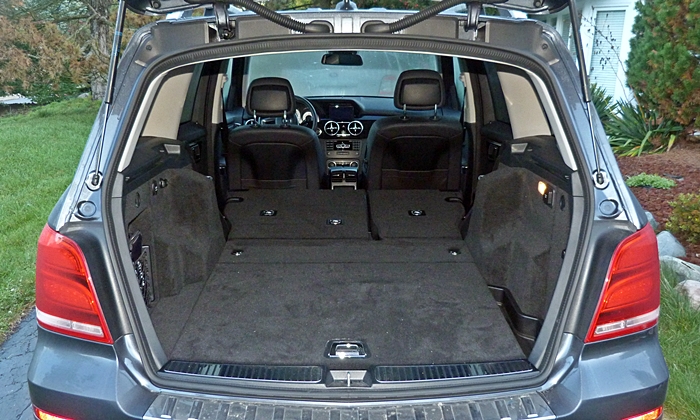
Less cargo room than most compact crossovers, but more than enough 99 percent of the time.
See more 2013 Mercedes-Benz GLK-Class photos
Mercedes-Benz provided an insured GLK250 for a week with a tank of diesel. The Audi Q5 was driven at a media association event.











